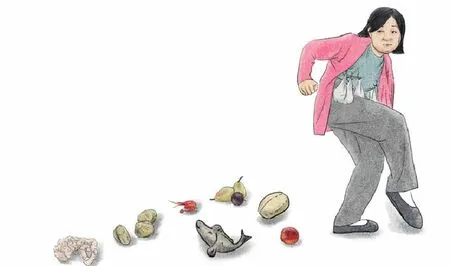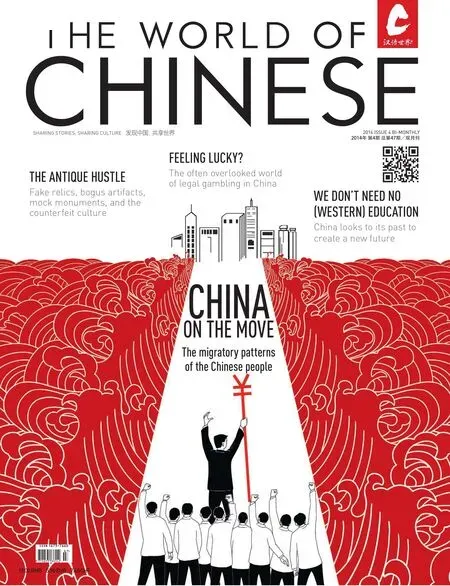MISHMASH
MISHMASH

BEST SHOPLIFTER EVER?
A middle-aged woman was arrested in June for shoplifting at a Walmart in Fuzhou. She almost made it out the door when a supermarket staff member stopped her, having noticed that she had smuggled pork tripe, clams, and cantaloupe in her bra. The clerks would have let her go if she paid, but the woman refused, claiming she didn't have enough money. Her stalling gave the clerks enough time to notice that her butt was a little too round for her body. When asked, she pulled out a bag of iced calamari and a fish that was, allegedly, still alive. It was later discovered that this woman was a professional (or at least very experienced) shoplifter. Small hooks were sewn onto her undergarments for her to hang various products, hedging her bets that no one would bother to check. — WEIJING ZHU (祝偉婧)
THE EAST IS RISING
“The East is Rising” isn't some Eastern plot for world domination. Not unless it's in the area of international prophylactic market share. They are, in fact, a group of university students who are unsettled by the state of condoms today. Size was noted as a particular cause for concern. “Current condoms on the market are relatively small in terms of coverage area, and accordingly have lower efficacy in preventing disease,” the students noted anxiously. Months of labor subsequently saw the team unveil the “Guardian Angel of Love”. To describe it merely as a “condom” would not do it justice. The inventors themselves describe it as a “pant-style prophylactic”. If that's confusing, then let's just say it looks like a pair of Y-fronts with a condom attachment seated on the front. That's not totally accurate, though. There is a diagram which we will not reproduce here for reasons of discretion, but make no mistake, this will offer comprehensive protection to the entire groin area. The blueprint is highly detailed, and points out features such as vertical streaks on the body of the condom itself, as well as its anti-skidding microcapsules. Choice of lubricant has also been clearly thought out, and TCM herbs have been incorporated into the mix that the six students have devised. — TONY HAN (韓歡平)

THE FAT BLACK SWAN INCIDENT
Pigs still can't fly, but in a somewhat perverse flip-flop of that idiom, an overweight swan plummeted from the skies of Shanghai in early June because it was too fat to fly. A driver, surnamed Yu, was waiting to load up his car in Shanghai's Qingpu District when a large clump of black fell from the sky, and right in front of his van. He got out of the car, and discovered that the unfortunate creature was a swan. A busy man during the day, Yu put the swan in his vehicle, taking it all over town as he continued working. On returning from work, Yu called the police who came and picked up the black swan and kept it in the police station while waiting for staff from Shanghai Wildlife Conservation Association to come to the rescue. The policemen complained to the reporter: “We even gave it vegetable leaves and water, but it's very ferocious, so we had to be careful not to be pecked by it when feeding it.” The swan was eventually adopted by the Shanghai Zoo, whose experts claim it was originally a black swan from Australia that, in all likelihood, escaped from a nearby farm and fell to the ground because it was too fat to fly due to being raised in captivity. — W.Z.
BUILDING A MUSEUM A DAY
Every city in China seems to want to show that it is modernizing and catching up with cities one tier above. Every city has or wants a CBD, and every city has or wants to build museums. Gong Liang, the director of Nanjing Museum, claims: “For the past three years, we (China) have been building museums at the speed of one per day.” As of the end of 2013, China had 4,165 museums, an increase of 299 compared to 2012. Professor Lu Jiansong from Fudan University has been researching this museum frenzy. According to national planning, China plans to have 6,000 museums by 2020. The problem, according to Professor Lu Jiansong, lies with the motives: “The government thinks museum construction is important...But, why build, how to build, and what to build are usually decided by the government or leaders, so (the museums) become decorations.” The high emphasis on appearance has turned the museum wave into a mine-is-bigger-than-yours competition, everyone seemingly wanting something bigger than what others have. For instance, the Wuxi Museum, constructed in 2007, was 71,000 square meters, even bigger than the Capital Museum. Some museums went for designs that were inappropriate for display, wasting a tremendous amount of space, and some designs were so nonsensical that they had to be demolished and started over. Lu says: “Some local museums are built exceptionally grand, but because they house no collections or display items, the museums were changed into shopping malls.” Even museums that successfully get up and running encounter financial issues down the line because most of the money went into constructing the building, leaving little to no support for collection and display. - W.Z.

